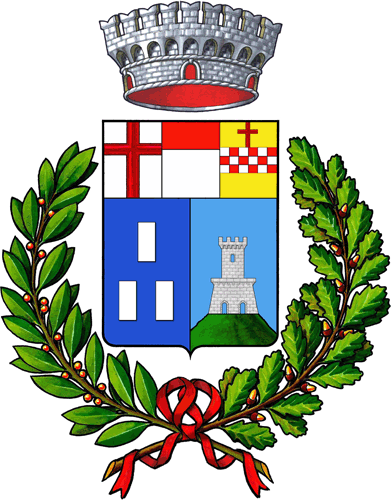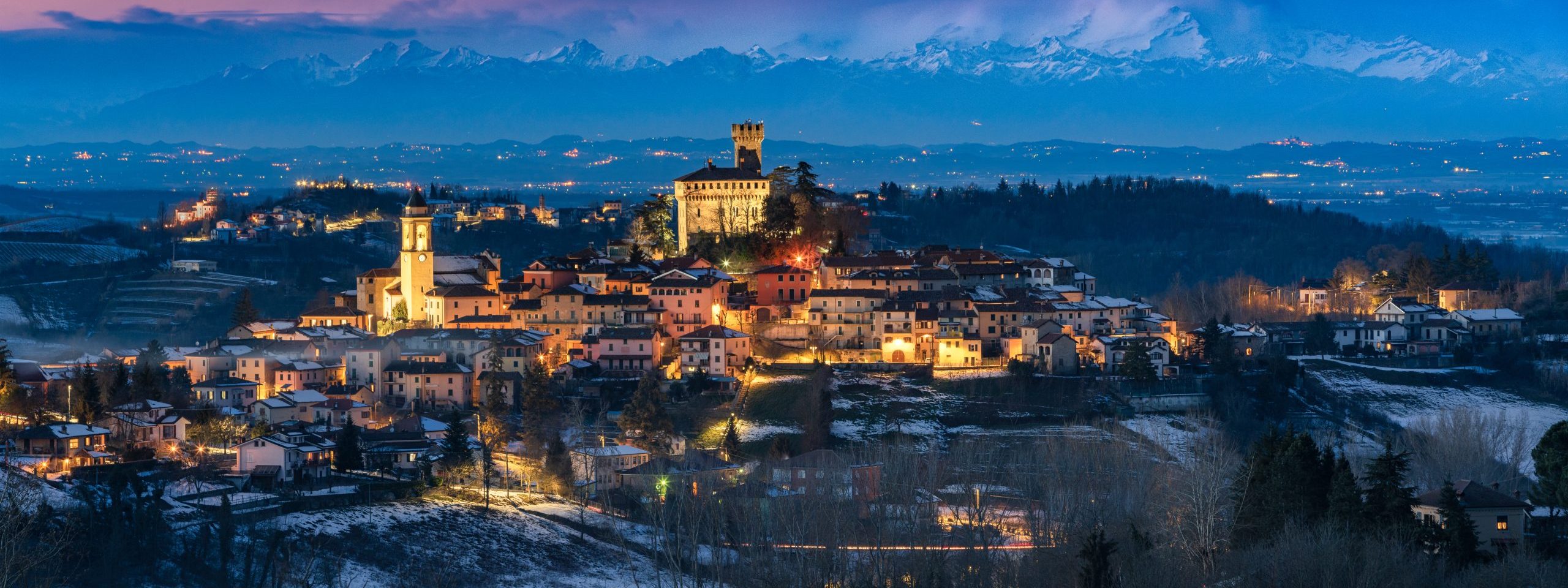Trisobbio, despite being a small village, can boast has a long past, which can be referring to documentary history and to the legends spread in the area.
In order to collect this information from different sources and present it in an organic way, we start from the municipal coat of arms.

The emblem
Trisobbio coat of arms was created in the 70s of the twentieth century and then officially approved through Presidential Decree n. 1296 dated 29 March 1982.
Even today there are municipalities without their own emblem, given that over the centuries, especially in the Middle Ages, only large cities and particularly important centers used their own coat of arms or their own symbol, while in most inhabited centers it was based on the coat of arms of the lord feudal, which with its seal guaranteed the official character of the acts.
In other centers the role of guarantor was assumed not by the temporal authority, linked to the empire, but by religious personalities ( such as Bishops, Abbeys, Convents).
The coat of arms is therefore surmounted by the crown of the municipality, which according to the rules appears as a circle of walls opened by four cordoned doors (three are visible), two of which on the outer edges.
The doors support a ring of walls with nine arches (sixteen in total), each surmounted by dovetail battlements (Ghibelline style), all in silver and walled in black.
Upper part
The upper part of the actual emblem is composed of a band with three sectors, each of which houses a coat of arms, indicating the main families that ruled Trisobbio over centuries.
Starting from the left, therefore we have:
The Coat of Arms of the City of Genoa, to which Trisobbio belonged for over a century;
The coat of arms of the Aleramici, Marquesses of Monferrato who were lords for 259 years and which also recalls the historical and geographical link to Monferrato;
The emblem of the Spinola family, from Genoa, who held the town with a marquis title for 263 years.
The Lower part
The lower part of the coat of arms can be divided into two sections:
On the left side, there are three plinths, which in heraldry take on the value of bricks and foundations, indicating constancy and stability of what is created, which represent the three legendary founders of the village.
The silver color indicates temperance, harmony and sobriety, the latter identifying the main quality of the founders.
The right side instead shows a fortified village, recalling the ancient “Castrum Trexobrii” and the two doors recall those that, in past centuries, gave access to the walled village from east and west.
The blue color that stands out on the two major partitions of the shield is an indication of fidelity to the homeland, perseverance in fruitful work and a view of hope.
The Legend
The legend Monferrato is a land of castles, testimony of a border area, where each inhabited center was entrusted to a noble (and sometimes divided among several of them) and therefore the “castle” or in any case the fortified village indicated the interest of the lord for that territory.
Consequently, where there are so many nobles, there were many disputes but, above all, also the need to trace their rights back to previous times, up to mythological figures.
Aleramo and the Monferrato
Aleramo is an example of a mixture of historical and legendary figure.
Related to historical sources we know that he obtained the first territories in 933 and then in 955 he received further lands in the current province of Alessandria, becoming a marquis in 958.
A few years later, he clashed with the king of Italy, Berengario II, his father-in-law, supporting the king of the Franks Otto I and obtaining new territories towards the Langhe, the Tanaro, the Orba and the Ligurian Sea.
The legend is reported for the first time in 1334 by a Dominican historian from Acqui Terme and then spread by Giosuè Carducci in his work Cavalleria e Umanesimo.
The legend tells that Aleramo and the daughter Alasia of Ottone I met while he was took part of the army of Otto I, then fled together on red (him) and white (she) horses.
Colors which composed the coat of arms of the Aleramici dynasty.
Subsequently, joined by Otto I, Aleramo received, either out of benevolence, or for the service rendered in the army, “the territories you will travel on riding”.
According to some versions the ride had to be uninterrupted using 3 steeds, according to others it had to be completed within 3 days and 3 nights.
During the ride, the horse lost an iron and Aleramo used clay (the one to make bricks) to replace it or, according to other versions, as a “hammer” to fix it again.
The use of brick (in dialect “mun”) to shoe (“frà”) the horse gave the name to the territory “munfrà” from which the current word Monferrato.
A version tells that during the ride Aleramo reached the sea and that place received the name of Aleramo’s wife Alasia, now the town of Alassio .
The Three Sobrii
The Origin of Trisobbio, on the other hand can be linked to another legend, which tells of how there was a group of people who crossed the territory of the current Monferrato, probably in search of new territories.
During the journey, several figures detached from the original group, each of which would have given origin and name to a settlement.
Trisobbio would therefore be founded by “three sober men” = Tres Sobri, brothers of seven inebriated men who stopped a short distance away, founding the center of Strevi.
From this legend comes the name, which is found with different spellings over time:
-1040 Trexobolo
-1202 the handwriting Trexoblio is also added
-1280 the form Trisobio appears
Prof. Geo Pistarino, University of Genoa, advanced the hypothesis that the village should have Etruscan origin, indicated by the suffix TAR, presents in the dialect name of the village, Tarsobi, would derive
History
The first traces of our village can be found in a document that can be dated between 1023 and 1033, in which Dudone, Bishop of Acqui, assigns the church of “Santo Stefano in Trisobbio”to the possessions of the Monastery of San Pietro, of the town.
Already in 1200 there are several notarial deeds that mention Trisobbio both indirectly (a notary “Giovanni del Castello di Trisobbio” was in service at the curia of Acqui) and directly as the location of the real estate properties sold.
In 1283 a deed was drawn up for land “in posse Trisobii”, indicating that the territory was under the local authority of a municipality, often identified in other deeds through the two canals that run through the valleys that flank the town, the Stanavasso stream (the valley where the swimming pools, the multi-sports complex and the green path are located) and the rio Budello (opposite side of the village).
In the Middle Ages, the village had its own system of weights and measures, while the use of Tortonese as a currency demonstrates trade and links with Tortona, leading to the territories of the Po Valley.
Taking advantage of the via Aemilia Scauri (which passes from Acqui Terme to Vado Ligure) and the Valle Stura (territory now crossed by the A26 and the Ex SS 456 “del Turchino”), the Trisobbiesi could reach the sea and the city of Genoa, where some records attest that they owned property.
At the beginning of this page , regarding the Coat of Arms, the Borgo di Trisobbio passed from the Aleramic marquises to the Spinolas, following defeats, agreements and gifts.
It should be noted that often it was not the entire village that changed hands, but only part of it (half, a quarter …) up to 1390 when the municipality is divided between the Marquises Malaspina who were fiefs from the municipality of Genoa (Giacomo q Tommaso and Antonio q.Antonio q. Tommaso) of two thirds of Trisobbio, while their relative Tommaso q.Isnardo Malaspina was already marquis of the remaining third.
Between the 1500s and 1600s, when the Malaspina dynasty ended, the title of lord was sold by the Gonzagas (fiefdoms from Emperor Charles V) to the Spinola family of Genoa.
sources (in italian):
https://it.wikipedia.org/wiki/Trisobbio
http://www.storiadiovada.it/art091.html
books and material edited by Municipality of Trisobbio.
